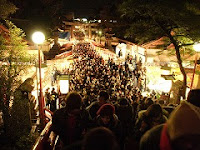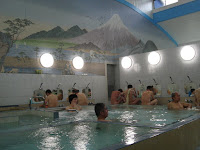初詣(はつもうで、Hatsumode)
Hatsumode is the first visit to a Buddhist temple or Shinto shrine in a new year.

There is the custom in Japan of making visits to temples or shrines at New Year, even if people are not Buddhist or Shinto believers, in order to pray for health and happiness, in the new year. On the occasion of hatsumode, people give money offerings, draw lots for written oracles, and buy good luck charms.

 |
| 絵馬(えま, votive picture) |
The crowds at famous temples and shrines are huge and are always broadcast on television newscasts.
*Top 10 popular temples and shrines for hatsumode.
1. Fushimi Inari Taisha (Shrine),
http://inari.jp/,
http://www.japan-guide.com/e/e3915.html
2. Meiji Jingu Shrine,
http://www.meijijingu.or.jp/english/

3. Heianjingu Shrine, http://www.heianjingu.or.jp/, http://www.japan-guide.com/e/e3904.html
4. Sumiyoshi TaishaShrine, http://www.japan-guide.com/e/e4007.html
5. Meguro Fdoson Ryusenji, http://park6.wakwak.com/~megurofudou/top.htm

http://www.mizuhiroba.jp/en/meisui/fudoson.html
6. Imamiya-ebisu Shrine, http://www.osaka-info.jp/en/facilities/cat21/post_301.html
7. Kawasakidaishi Heikenji Temple, http://www.jnto.go.jp/eng/location/spot/shritemp/heikenji.html
8. Shimogamo jinja, http://www.shimogamo-jinja.or.jp/english.html
9. Tokyo Daijingu, http://www.tokyodaijingu.or.jp/english/
10. Kitano Tenmangu Shrine, http://www.japan-guide.com/e/e3939.html
































